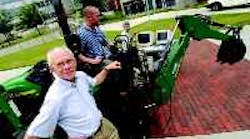Professor Wayne J. Book (front) heads a Georgia Tech team that's exploring ways to give electronic controls the tactile feedback associated with manual controls. His group, which includes graduate student Matthew Kontz (center) and research engineer James Huggins, are currently focusing their efforts on a backhoe control. Photo by Gary Meek.
Associate Professor Imme Ebert-Uphoff (left) and graduate student Paul Bosscher examine a mock-up illustrating the kinematic ability of an array of joints that could create a "formable crust" of digital clay — a type of computeraided design that is worked in 3D like modeling clay. Photo by Gary Meek.
Graduate student Matthew Kontz works with a haptic manipulator, an input device for haptics experiments.
Haptics is hot at Georgia Tech's Mechanical Engineering Department. Researchers there are exploring how haptic feedback gives machine operators a "feel" for controlling mechanical devices such as earthmoving equipment, automobiles, and aircraft. Their work could make it easier to operate electronic controls, which typically lack the tactile response of manual controls.
"Haptics is focused on your kinesthetic senses, the forces you feel in your joints and muscles as you move your body and the way the environment reacts to that motion," explains Wayne J. Book, professor of mechanical engineering and research-team head. In many cases, says Book, people need a tactile connection with the machine or vehicle they're operating.
Currently, Book and his graduate students are working on haptically enhanced controls for backhoes. The team believes such systems could make machines more intuitive for end users and, hence, safer and easier to operate.
The backhoe-control project is supported with equipment and funding from John Deere, Sauer Danfoss, Balluff, WIKA, Hydac, HUSCO, Ford Motor Co., and the National Fluid Power Association.
Book's group is also experimenting with forklift control. They fitted a laboratory-scale hydraulic lifter with a commercially available haptic interface that connects to proximity sensors. The sensors trigger the feel of a wall, says Book, letting operators gently and precisely pick up loads.
Another project focuses on "digital clay," a type of computeraided design that is worked in 3D like modeling clay. With digital clay, the haptic surface displays all of the 2D attributes of an object with added features — such as texture and hardness — associated with shape.
On a typical computer screen, "you have limited degrees of freedom with an object," Book explains. "You can rotate and roll it, move it around, but that's it." He says that digital clay lets designers describe objects in a more natural way to a computer. "If you want to display it as a soft surface, you can have it respond by yielding when you push on it. If you want to display a hard surface, you have it yield only slightly or not at all."
So far, the work has resulted in a 100-cell square grid that responds to shape commands. Future plans are to expand the size of the grid while increasing resolution.




